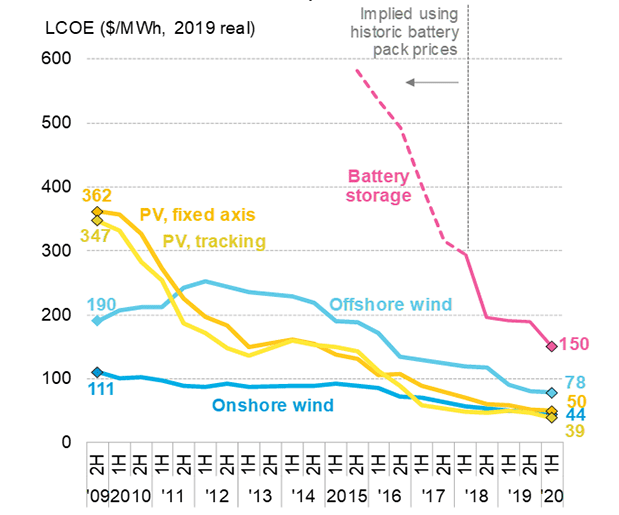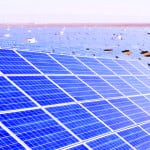Onshore wind and photovoltaic (PV)
solar power are the cheapest forms of new-build power generation for at least
two-thirds of the world’s population, according to analysis published by research
company BloombergNEF (BNEF). Meanwhile, battery storage has become the lowest-cost
new-build technology for peaking purposes in gas-importing regions, such as
Europe, China, and Japan.
BNEF reported on April 28 that the global levelized cost of electricity (LCOE)—which measures the all-in expense of producing 1 MWh of electricity from a new project including the costs of development, construction and equipment, financing, feedstock, and operation and maintenance expenses—fell to $44/MWh for onshore wind and $50/MWh for utility-scale PV in its latest study. It said the cost has decreased 9% and 4%, respectively, since the second half of 2019.
“There have been dramatic improvements
in the cost-competitiveness of solar and wind,” Tifenn Brandily, lead author of
the BNEF report, said in a statement. “Part of it is due to photovoltaic and
wind technology getting better at extracting renewable resources. But our
analysis also suggests that since 2016, auctions are forcing developers to
realize cost savings by scaling up project size and portfolios. Larger scale
enables them to slash balance-of-plant, operations and maintenance expenses—and
have a stronger negotiating position when ordering equipment.”
An increase in onshore wind turbine sizes has been driving costs down in that sector. The average size of new wind turbines is 4.1 MW, with recently financed projects costing about $700,000/MW. BNEF said Brazil, which is flush with wind resources, has seen the lowest LCOE in the world ($24/MWh) for best-in-class onshore wind projects. Top projects in the U.S. are not far behind ($26/MWh), while projects in India and Spain were coming in at $29/MWh, according to the analysis.
In China, which has the largest PV
solar market, BNEF’s solar benchmark was $38/MWh, a decrease of 9% from the
second half of 2019. However, BNEF expects the LCOE for some recently financed
PV projects will be between $23/MWh and $29/MWh.
A decade ago, solar generation costs were well over $300/MWh, while onshore wind power was more than $100/MWh (Figure 1). If current trends continue, the LCOE of best-in-class solar and wind projects will be less than $20/MWh before 2030, Brandily said. “And there are plenty of innovations in the pipeline that will drive down costs further,” he added.

The LCOE of battery storage has
been cut in half since 2018 due mainly to larger project sizes, a rapidly
expanding manufacturing base, and more energy-dense chemistries. BNEF’s global
benchmark for battery storage now sits at $150/MWh for systems with a four-hour
duration. In China, where prices are the cheapest, battery storage is only
$115/MWh.
While BNEF’s analysis is based
on real projects starting construction and proprietary pricing information from
suppliers, and the data used for the latest report came from actual deals over
recent months, it does not reflect what may happen to the LCOEs of different
generation technologies as a result of the economic shock caused by the COVID-19
pandemic.
“The coronavirus will have a
range of impacts on the relative cost of fossil and renewable electricity. One
important question is what happens to the costs of finance over the short and
medium term. Another concerns commodity prices—coal and gas prices have weakened
on world markets. If sustained, this could help shield fossil fuel generation
for a while from the cost onslaught from renewables,” said Seb Henbest, chief
economist at BNEF.
—Aaron Larson is POWER’s executive
editor (@AaronL_Power, @POWERmagazine).










